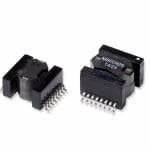source: Exxelia news
Exxelia will exhibit innovative ranges of wound magnetic components at 2017 Applied Power Electronics Conference, Tampa, FL, from March 27-30. Notable at Exxelia’s booth #623, will be products based on the highly customizable Chameleon Concept Magnetics (CCM) Technology. The CCM technology adapts to most every need, even the harshest environments, including VIGON® resistance.
Exxelia will exhibit the CCM series during the Applied Power Electronics Conference at Exxelia’s booth #623 from March 27-30, 2017 in Tampa, FL. Exxelia designed CCM technology to respond to the growing interest of electronic engineers for inductors and transformers with multiple outputs, high power density and reduced footprint.
Qualified for aeronautic and space applications, the CCM product line features terrific robustness. The monolithic design provides high mechanical performance, proven by the successfully testing in accordance with MIL-STD-202 (methods 213 and 204).
The series offers five different sizes, allowing optimized component design in a pick-and-place surface mount (SMD) package. Through-hole (TH) packages are also available upon request. The CCM series is particularly flexible with a number of pins options available, from 2×6 pins for the smallest package, up to 2×10.
CCM transformers and inductors can operate over a wide temperature range with a minimal temperature of -55° C. The standard thermal grade of the technology is 140° C. Thanks to the technology design, the thermal resistance is 30% lower than standard industrial components. The epoxy molding protecting the winding ensures a lower temperature gradient and a better heat dissipation. Each unit is thoroughly tested with a dielectric withstanding strength of 1,500 VAC. Component materials meet UL 94-V0 rating.
Exxelia can evaluate losses and related temperature rise thanks to an in-depth knowledge of CCM technology. Thermal resistance data is available for each package size. Exxelia can also manufacture products in CCM technology according to MIL-STD-981.






























